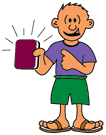
Reader's Theater

Goals:
1. Students will learn to make decisions in a team and to work together efficiently and cooperatively.
2. Students will use communication skills to complete presentations.
Resources:
1. Multiple copies of various children's literature dealing with ships or the ocean. (Typed copies will work best.) See:
2. Construction paper, markers, scissors, glue, tape, etc.
3. Highlighters
4. *If you choose to use Timothy of the Cay you will need to have various sections of the book typed with multiple copies. (Suggested passages pg. 49-51, 54-56, 1-5, 102 (he hurried)- 105,107-112, 129-132.
Time:
The time will vary depending on the number of groups you have and how in depth the students want to make their props and presentations. The average time will be 2 to 3 hours.
Procedure:
Introduction: Students will become familiar with various types of children's literature dealing with their topic. (Sample Questions for Interviewing)
Step 1 Teacher explains the process of Reader's Theater. (For a complete explanation of Reader's Theater see attached sheet.)
Step 2 Students will choose the book or section of the novel (Timothy of the Cay attached) that they would like to perform. The students who choose the same book or section will be in one group.
Step 3 Students will be allowed time to read through the material alone and then read it through - out loud in the group.
Step 4 Students are to decide how the book or section should be scripted, who is going to play each character and so on.
Step 5 Next students will be given time to practice their reading. At this time students will hopefully want to make props and things to go along with there reading. Have materials handy.
Step 6 Each group will present their Reader's Theater and share what they learned about working in a team and making decision. (Add this to their journal.)
Assessment:
1. Each group will perform their Reader's Theater for the class. (Criteria for success = The performance is original, props are well done and incorporated, volume and overall presentation is good. See attached rubric for an example.)
2. Cooperation and group work will be observed. (Criteria for success = Group evaluation sheets filled out and teacher observation on organization, presentation, preparation and how well worked together during the process.)
3. Students will add to their journal what they learned from this experience about working in a team and making decisions as a team. (Criteria for success = Must be turned in, complete information, neatness, organization, meet requirements of each lesson or entry.) See journal rubric.
Curricular Strands and Major Concepts:
1. Language Arts - Using Children's Literature as a tool for learning about ships. (If you use Timothy excerpts it will allow students to bring to life a section of the book in there own way.)
2. Art - Using creativity to develop props.
Possible Extensions:
1. Students could write a song about a ship.
2. Perform a play about ships.
3. Poetry - Iliad